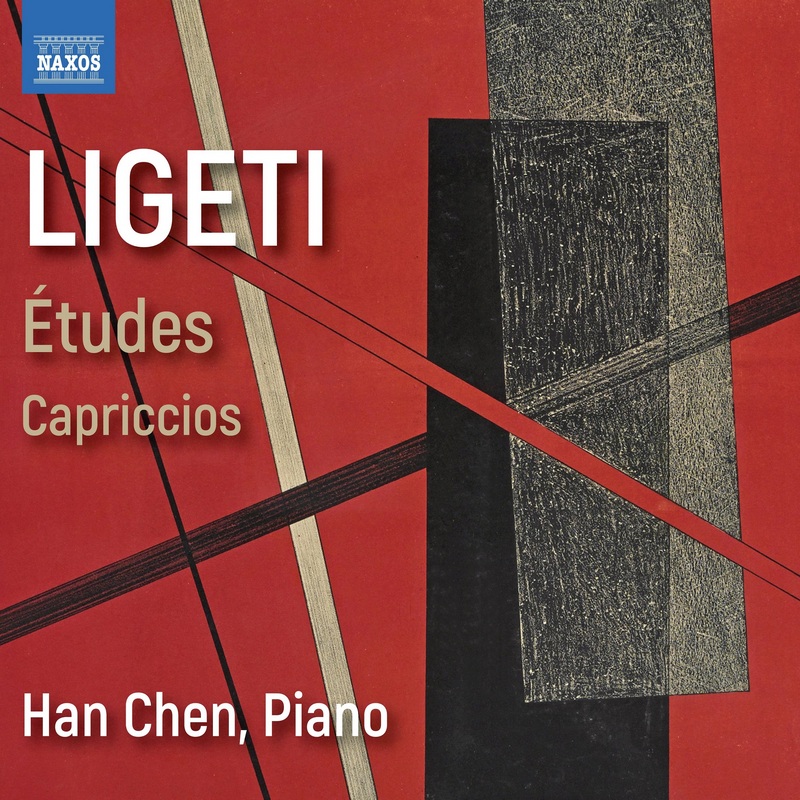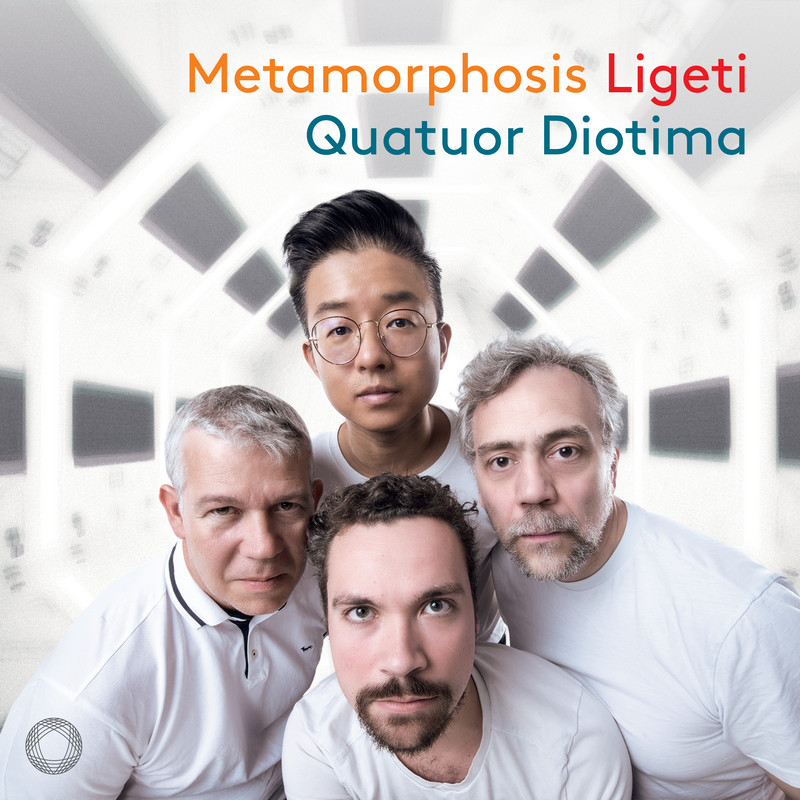Today marks the 100th anniversary of the birth of György Ligeti, one of the 20th century’s most significant and consistently engaging composers. i’ve been spending time lately with three new releases that together present an excellent overview of Ligeti’s output, from the perspectives of his music for piano, choir and string quartet.

From pianist Han Chen comes a new album featuring all three books of Études, together with both Capriccios. Perhaps for reasons of sonic variety, they’re arranged on the album in the sequence Book 1, Book 3, the Capriccios, and Book 2, but i took my usual approach with releases of this kind and listened chronologically. In this way, the two short Capriccios, composed in 1947, act as an introduction that, with their air of whimsical mischief, subtly differ from what’s to come, though their emphasis on a single idea being worked through – in the first Capriccio especially, like trying to unravel a tightly wound little knot – they do bear a similarity to the fundamental nature of the Études.
My suggestion that the Capriccios here sound as a playful contrast to the Études is primarily because Han Chen’s approach is somewhat ‘scientific’ (though never clinical), inasmuch as he makes the single idea in each Étude his absolute focus. It’s an approach that proves conducive, not simply making each Étude an immersive experience but convincing us that, for its duration, its behavioural nature and limits are all that are possible. It’s as if we were listening to a sequence of experiments, each temporarily redefining the laws of physics. Chen’s approach also makes total sense with regard to these works’ overall name: these are pieces that literally study, observe, set an idea in motion and see what happens as it plays out. (As such, they consistute the next stage of development from Ligeti’s early Musica Ricercata, a work similarly intended to “research” compositional outcomes.) Throughout this album i found myself imagining Han Chen sitting at the piano wearing a white coat, the studio around him transformed into a laboratory.
The Études thus become a series of diverse investigations, producing swirling cycles, half repetitions and churning surfaces (Désordre), jittery staccato spasms (Touches bloquées), a stained-glass window kaleidoscope effect (Arc-en-ciel), and an ambitious cavalcade of burbling speed and measured chords held in a tension that develops into fluid, overlapping torrents (Automne à Varsovie). And all of that’s just in Book 1. Chen allows for significant contrasts, plainly evoking the influence of Bartók in Fanfares, keeping things steady, even flat, in Galamb Borong, while at the same time forging a strong sense of both continuity and interconnectedness, such that all 18 Études, despite being composed over a 26-year period, sound united and part of a consistent whole. Other highlights: Vertige has never sounded more like a piece of Bach performed by a player piano with the tempo set far too high; from the rapid chugging of Columna infinită Chen teases out the shape within, as if carved from something semi-solid; the rapid sense of falling resulting from the overlapping cascades of White on White (forming a clear link to No. 6); and the way À bout de souffle conveys both a sense of dancing elegance while maintaining the integrity of its ongoing process. Overall, it’s a superb, fresh take on one of the most significant contributions to the piano repertoire of the last century.

Ligeti’s large amount of unaccompanied choral music is explored in its entirety on a new double album from the SWR Vokalensemble, conducted by Yuval Weinberg. Again, the ordering on the album is somewhat haphazard; again, i approached it all chronologically. Where the piano music shows great consistency throughout Ligeti’s life, the choral works illustrate a pronounced change. Most of them, from the period 1941 to 1955, can be thought of as ‘folk’ pieces, often drawing on Hungarian folk tales and alluding to folksong. (This correlates with Ligeti’s instrumental works from the same period, Régi magyar társas táncok (Old Hungarian Ballroom Dances), Baladă și joc (Ballad and Dance) and Concert Românesc). As such, they exhibit a different kind of personality, rarely aspiring to the obsessive thrall to ideas and processes heard in the Études, instead invoking the quotidian silliness and sadness of ordinary people. Ligeti was clearly drawn to these emotional opposites – weddings and death feature often, sometimes in the same song – though his musical language is often disarmingly simple, seeking less to portray the emotions than present them with a minimum of fuss or artifice.
The earliest song, ‘Choral’ (1941), is little more than rather stately triads (mostly in root position) coloured by some oblique progressions, and even as Ligeti’s vocal approach develops, the songs’ harmonic nature remains firmly placed within clear tonal or modal configurations. What bestows charm and individuality on these songs is the way Ligeti shapes the texts: a shift from tutti to soloist when the words become personal in ‘A varró lányok’ (The Seamstresses); juxtaposing lively and ruminative states in ‘Temetés a tengeren’ (Burial at Sea), the first song to show more significant expressive imagination; an atmosphere of wafting, dreamy semi-stasis being abruptly broken in ‘Magány’ (Solitude), in the process definitively moving further from conventional harmonies; and the simple block writing and unabashed big triads permeating the two ‘Balassa Bálint-kórus’ (Bálint Balassa Choruses), fully embracing the words’ basic, shouty elation.
There are almost 90 minutes of these songs, comprising three-quarters of the album, but at almost no point do they give any indication of where the last three works would go. Perhaps the only clue is the final word of ‘Tél’ (Winter), a short, strident piece from 1950 ending with the question, “What is winter’s message? What?”, that closing word projected outwards as an stunning, blazing cluster. Close collisions occur often in the earlier choral works, but this chord is the only example of a true cluster. All of which makes 1966’s Lux aeterna – coming after a break of 11 years, the first significant hiatus in Ligeti’s choral output – such an astonishing and unexpected achivement. (Of course, from the perspective of Ligeti’s entire output, this development had begun five years earlier, with the orchestral work Atmosphères.) Unlike pretty much everything else on this album, it’s a well-known work that’s been recorded many times (whereas four of the songs have never been recorded before), yet i was surprisingly struck by how much the piece felt like a continuation of those earlier pieces. The folk elements were gone, yet within its shifting clusterscape there was a recurring sense of askew quasi-tonal unity, particularly when the music pauses on particular pitch agglomerations.
That’s not the case in the final two works, the 3 Phantasien (3 Fantasies) and Magyar etüdök (Hungarian Studies) from 1982 and 1983 respectively, works that delve further into a demonstrably avant-garde language. However, particularly in the Phantasien, they remain just as immediate, tapping into dreamy ecstasy while utilising octave doublings to anchor the music and keep it just as grounded as the more obviously folk-inspired music. It’s to the SWR Vokalensemble’s enormous credit not only that they’re able to tackle such a vast amount of music with such aplomb but that they can switch so effortlessly between markedly different modes of expression. It’s as ambitious an undertaking as it is a rewarding listening experience.

Ligeti’s relatively small output for string quartet is brought together on a new album from Quatuor Diotima. Similar to the make-up of the piano music, it also comprises a small early trifle, the Andante & Allegretto from 1950, followed by two substantial quartets. i call it a trifle, but the Andante & Allegretto is certainly pretty, two 6½-minute movements that move from broad, thoughtful lyricism, suggesting considerable outward scope from a place of inward intimacy, to equally gentle, folk-like, cheerfulness.
None of which serves as preparation for the intense behavioural rigour of Ligeti’s subsequent two String Quartets. No. 1, from 1954, progresses through its dozen movements remarkably swiftly, at almost all times holding the players together as a single group. The Diotimas huddle and play wonderfully, bringing a slight roughness of tone in the Vivace, capriccioso second movement before exploding with energy, tripping along (and practically tripping over) in the Presto fourth movement, managing to slip-slide and scrunch simultaneously, in turn becoming a good-natured racing romp when Ligeti ramps it up in the following Prestissimo. The seventh movement waltz is rendered deliciously sleazy, and increasingly there’s the sense of a mischievous game, one that doesn’t shy away from rhythmic messiness in the tenth movement, while improbably finding a path to weird transcendence in the twelfth.
While String Quartet No. 2, composed 14 years later, demonstrates a similar behavioural focus, the Diotimas fittingly bring an altogether different group dynamic to the work. The frivolity is gone, replaced now with a fretful nervousness and, with it, an extreme volatility. Notes jitter and skitter; bows slash like murder weapons; rhythms cross and collide; and everything regularly recoils into dark, barely audible, shivering tremolandos. It’s a place defined by anxious uncertainty, one that here forms a telling counterpart to the playfulness of the First Quartet. The outbursts increasingly sound like so much pent-up emotion rupturing the surface, while the unexpected appearance of a gentle, barely lyrical idea in the final movement indicates both pathos and tragedy, all the more so as it gets quickly lost in further rapidity and violence, the work’s closing mix of tremulous and sustained notes forming a genuinely enigmatic, pseudo-resolution.
All three of these albums are available on CD and download: Han Chen’s album of the Études and Capriccios is released by Naxos, the SWR Vokalensemble’s Complete Works for a cappella choir double album is on SWR Classic, and the Quatuor Diotima disc, titled Metamorphosis, is on the Pentatone label.
